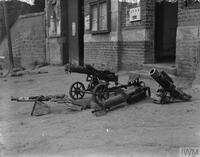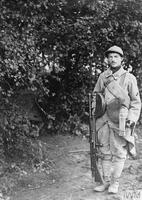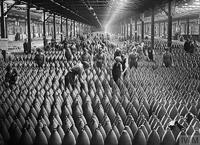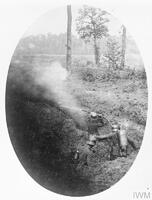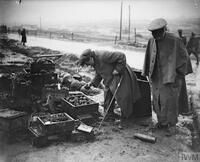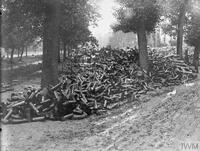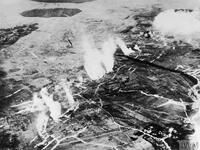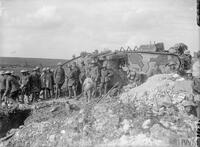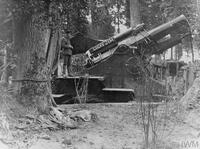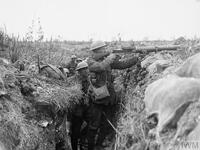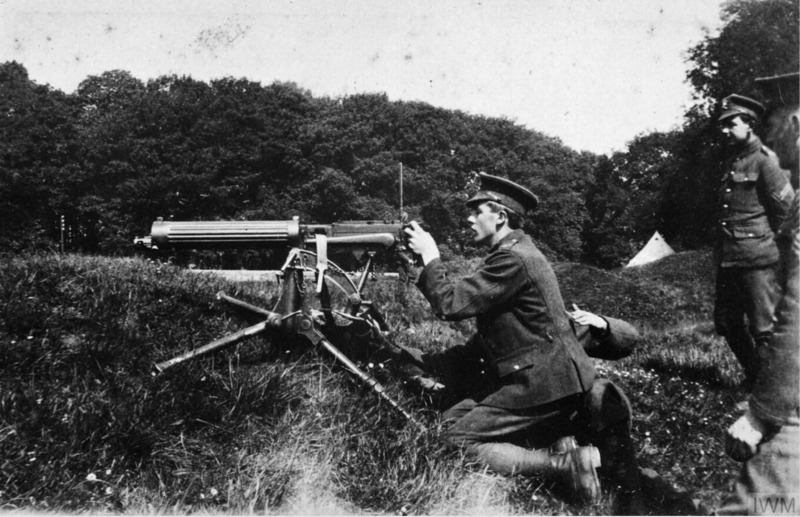Modern Weaponry
Artillery (Howitzers, Siege & Heavy Field Artillery)
Artillery was the most important for an army conducting land warfare to have. Various types included the heavy 15-inch, 8-inch, and 4.5-inch howitzer. Fired high explosives and shrapnel were used for material destruction such as trenches, communication lines, wire fencing, roads, and anything that helped the enemy move (including animals). The heavy howitzers were popular due to its pinpoint precision and intense concussive effect. Artillery was not new, but these weapons were undoubtedly improved, especially after the Second Boer War, which ended in 1902. For example, the British developed a new and improved 9.2-inch siege howitzer.
The lightest and more mobile guns like the 18-pounder guns and 4.5-inch howitzers fired small shrapnel or high-explosive shells out to approximately 6000 yards. The second kind included 60-pounder guns, 4.7-inch guns, and 6-inch guns firing high-explosive shells to about 10,000 yards. The heavy artillery pieces fired 100 to 1400 pound shells at a high-angle trajectory a distance between 5,000 and 11,000 yards. The main purpose of the 18-pounder gun was machine gun suppression and wire-cutting, as seen with the June preparatory barrages with the high number of shells fired.
Field guns were another type of weapon commonly employed. Although this was not a new weapon, it was enhanced with better techniques and reduced cannons' weight. In 1815, during the Napoleonic Wars weight of the cannon was about 1,650 pounds, while during WWI, it was around 800 pounds. This helped improve the gun with a more incredible muzzle velocity, a flatter trajectory, and an extended maximum range.
Although, it is important to note that artillery failed to destroy the barbed wire and sufficiently kill the enemies in the front-line trenches, as exemplified during the Battle of the Somme because of faulty shells. That being said, artillery was the most destructive weapon and caused the most casualties. The guns shot high explosive shells, shrapnel, and poison gas at the enemy, and heavy fire could destroy the trenches and other fortified positions.1 To get sense of the amount of artillery just the British possessed on the opening day on the Battle of the Somme, explore the pie chart below. The data comes World War I Battlefield Artillery Tactics.2
Machine Guns
One of the most influential technological advances pre-WWI was the invention of the machine gun by Hiram Maxim who developed an automatic weapon in 1883. T For the British Army their gun was the “Vickers-Maxim," named after the Vickers Company in England. This invention gave the infantry soldier domination over the defensive battlefield. The machine gun was an automatic weapon which had an inhuman lethality to it that was comparably different than an average rifle. The it was a weapon with qualities like functional efficiency, portability, and compactness. In regard to the British Army, they established the Machine Gun Corps to put well trained Machine Gunners in every battalion in order better prepare for future battle; around 12,000 guns in 1914 to 100,000 in a very short amount of time. Although, the Germans are most known for the use of this weapon during war. To get a sense of weapon, the Vickers machine-gun could fire over 600 rounds per minute and had a range of 4,500 yards. The weapon was capable of firing six to seven hundred rounds per minute. It provided the infantry with a very effective source of firepower with a low cost in manpower and resources. In previous offensive operations, the basis for success was numerical superiority and efficient use of cavalry.
Chemical Weapons
WWI also saw the introduction of chemical warfare in the early years of the war. The Germans first used gas, specifically chlorine gas. This type of gas is very corrosive. It is deadly to humans and animals as it kills them by destroying lung tissue. As the war progressed, all sides developed more lethal gases, including chlorine, phosgene, and mustard gas. Chemical weapons were shot from howitzers were shrapnel shells mixed with gas shells. Gas shells were used for last-minute counter-battery fire. Between the Battle of the Somme and May 1917, the British used mainly chlorine and phosgene gas in over 100 operations and employed nearly 40,000 cylinders. Chlorine gas attacks were easy to detect due to its strong smell and the visible green-yellow cloud. The infamous mustard gas did not come into play after the Battle of the Somme. After the war, chemical weapons were banned by the Geneva Convention in 1925. Gas was not universally deadly, as only 91,000 deaths ultimately were caused by gas despite 1.3 million casualties. 3
Tanks
For the Somme offensive, General Haig hoped to use a new weapon of war, the tank. General Haig believed this new piece of machinery could assist in breaking German lines. Until WWI, the use of tanks was non-existent. Although the tank was introduced during the Battle of Somme, no tanks were available until September. Tanks were employed for the first time on September 15th with some success, though they did not achieve a major breakthrough. As a result of the tank, the intensity of the battle continued. Tanks continued to be of great use, but there was a low quantity of them as there were less than 50 tanks on the Somme battlefields.4
Trench Mortars & Mines
Mortars used on the Western Front came in various sizes. Mortars could be fired from the trenches because of their size and mobility. They were effective at taking out an enemy machine gun and sniper posts. While mines (also known as Minenwerfer) were buried, tunnels were dug under ‘no-man’s land’ beneath enemy positions.
Handheld Weapons (Grenades, Flamethrowers, Rifles)
All those in combat commonly used rifles. For example, the Short Magazine Lee Enfield Rifle Mk III was a standard rifle, and infantry rifles were equipped with a bayonet. It had a maximum range of 2,280 meters but an effective killing range of 550. Additionally, the Lewis Gun was the British Army’s most widely used machine gun. Another weapon frequently carried by soldiers was grenades. Lastly, teams of soldiers used flamethrowers, but they were not considered artillery and were not commonly used by the British. However, they launched them on the Somme, called Livens Large Gallery Flame Projectors.
Notes
- Dale Clark. World War I Battlefield Artillery Tactics. (Oxford: Osprey Publishing, 2014).
- The data behind the chart comes from Horne's World War I Battlefield Artillery Tactics.
- Chang, Hasok and Catherine Jackson. "An Element of Controversy: The Life of Chlorine in Science, Medicine, Technology, and War.” Isis 101, no. 3. (September 1, 2010): 240.
- David P. Cavaleri. Overcoming the Battlefield Stalemate: The Introduction of Armored Fighting Vehicles and Tactics in the British Army During the First World War. (University of Missouri-Columbia, May 1993).
Further Reading
- Cavaleri, David P. Overcoming the Battlefield Stalemate: The Introduction of Armored Fighting Vehicles and Tactics in the British Army During the First World War. University of Missouri-Columbia, May 1993.
- Clark, Dale. World War I Battlefield Artillery Tactics. Oxford: Osprey Publishing, 2014.
- Horne, Charles F. Source Records of the Great War; a Comprehensive and Readable Source Record of the World's Great War. Indianapolis: The American Legion, 1923.
- Khan, Sal. “Technology in World War I.” Khan Academy, 2012. Accessed March 18, 2022. https://www.khanacademy.org/
- National Army Museum. “Weapons of the Western Front,” Accessed March 18, 2022. . https://www.nam.ac.uk/explore
- Padley, AP. “Gas: The Greatest Terror of the Great War.” Anesthesia and Intensive Care 44, no. Supplement 1 (July, 2016): 24–30.
- The Great War. "Flamethrower Units - Handling of Prisoners - Artillery Fuzes," YouTube Video, April 17, 2017. Accessed March 18, 2022. https://www.youtube.com
- The Great War. "Poison Gas Warfare In WW1 I THE GREAT WAR Special," YouTube Video, April 7, 2015. Accessed March 18, 2022. https://www.youtube.com
